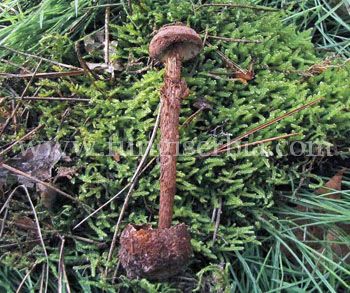Battaraea phalloides (Dicks.) Pers.

Fruit body: at first as an underground egg up to 4 cm. Mature specimen with a basal, hypogeous volva, at the base of of brown woody stem tall 15 or more cm. Mature gleba at the top is covered by the endoperidium, wich falls off and exposes the brown pulverulent convex surface that remains.
Microscopy: spores broadly ellipsoid, ornamented with warts and ridges forming an incomplete to almost complete network, 8-9.5x6.5-8 μm.
Flesh: stem tough and often hairy.
Habitat: on dry, usually sandy terrains, sometimes associated with ash (Fraxinus), yew (Taxus) or pine (Pinus).
Edibility: inedible.
References:
Pegler, D.N., Laessoe, T., Spooner, B. (1995). British puffballs, earthstars, and stinkhorns,
Photo: Goran Milošević